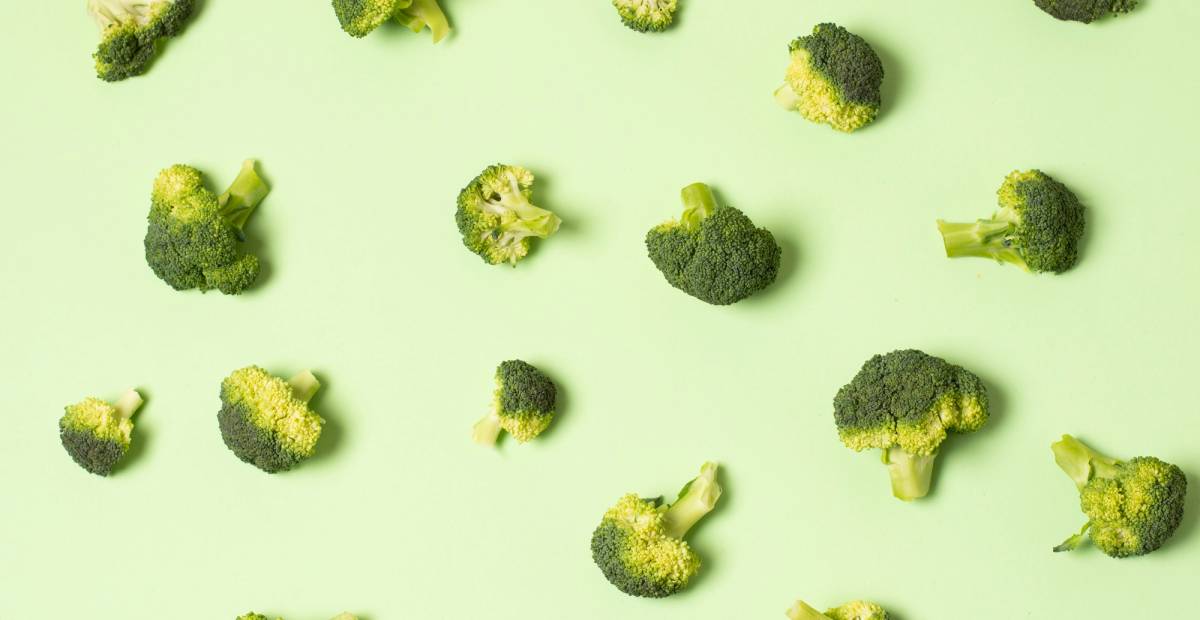Prebiotic Fibres in Broccoli & Short-Chain Fatty Acid Production

Broccoli Fibre 101: Does Broccoli Have Enough Fibre to Matter?
How Much Fibre Is in Broccoli?
According to USDA FoodData Central (FDC #11090), one cup of chopped raw broccoli (91 g) supplies 2.4 g dietary fiber—roughly 9 % of the daily recommendation. Steaming concentrates that value to 4 g per cooked cup (156 g), while a heaped tablespoon of sprout powder averages 1.5 g. Such figures confirm that broccoli is a moderate-to-high fibre source relative to its calorie load.
Soluble vs Insoluble Breakdown
Laboratory assays show a 60 : 40 split in favour of insoluble fibre—cellulose and hemicellulose—versus soluble pectins that dissolve in water and gel in the colon. The soluble fraction is the main substrate for Bifidobacteria-driven butyrate synthesis, whereas insoluble fragments add stool bulk and speed transit. Pairing florets with myrosinase-rich sprouts intensifies this effect and complements the sulforaphane focus of our guide to broccoli sprout supplements vs fresh sprouts for readers comparing formats.
Broccoli vs Other High-Fibre Vegetables
Broccoli’s 2.4 g per cup beats raw carrots (1.7 g) and equals cooked kale (2.6 g per 118 g), yet falls below navy beans (9.6 g). What makes broccoli notable is its cruciferous matrix: glucoraphanin, lignans and polyphenols work alongside fibre to promote a diverse microbiome. A clinical crossover trial in Gut Microbes (2023; 15:2251132) found that eight weeks of daily broccoli intake raised faecal butyrate 15 % more than an isocaloric spinach control—underscoring broccoli’s unique prebiotic profile.
Prebiotic Pathway: From Broccoli Fibre to Short-Chain Fatty Acids
Key Gut Microbes Fermenting Broccoli Fibre
A 2023 mechanistic review reported that Bifidobacterium longum and Lactobacillus plantarum possess specialised pectinolytic enzymes that break down the soluble fraction of broccoli fibre, releasing sugars that fuel bacterial growth and SCFA synthesis. (pmc.ncbi.nlm.nih.gov) Controlled fermenter studies confirmed a two-to-three-fold rise in these taxa when broccoli residue replaced cellulose as the sole carbon source. (mdpi.com)
The insoluble component—chiefly cellulose—passes to the distal colon, where Roseburia and Faecalibacterium prausnitzii finish the job, ensuring a steady butyrate trickle across the large bowel. This multi-step degradation explains why broccoli produces a sustained, not rapid, SCFA release profile.
SCFAs Explained — Butyrate, Propionate, Acetate and Their Roles
Anaerobic fermentation converts hexose units into three principal SCFAs: butyrate, propionate and acetate. Butyrate supplies up to 70 % of the energy required by colon cells and tightens junction proteins such as claudin-1 and occludin. (sciencedirect.com) Propionate travels to the liver, where it dampens de-novo lipogenesis and moderates gluconeogenesis; acetate enters systemic circulation and supports peripheral cholesterol balance. A meta-analysis in Nutrients linked higher faecal butyrate to lower C-reactive protein and improved insulin sensitivity. (pmc.ncbi.nlm.nih.gov)
For readers focused on epithelial resilience, see our in-depth review of broccoli’s role in gut barrier integrity.
Strengthening the Intestinal Barrier & Calming Inflammation
Eight-week broccoli interventions in rodents with metabolic dysfunction boosted colonic butyrate 22 % and reduced interleukin-6 gene expression by half, indicating simultaneous metabolic and inflammatory benefits. (mdpi.com) Human observational data echo these findings: a cohort consuming ≥ 150 g broccoli daily exhibited tighter zonulin profiles than low-intake controls, a marker of reduced intestinal permeability. (news-medical.net)
SCFAs also activate G-protein-coupled receptors GPR41 and GPR43, triggering anti-inflammatory cascades and maintaining a balanced T-regulatory cell pool—crucial for preventing dysbiosis-driven conditions such as irritable bowel syndrome. Experts writing in Gut Microbes conclude that cruciferous vegetables “offer prebiotic, anti-inflammatory and barrier-protective effects unmatched by most leafy greens.” (sciencedirect.com)
Comparative Spotlight — Why Cruciferous Fibre Outperforms Many Prebiotics
Sulforaphane + Fibre Synergy for Microbiome Resilience
A Nutrients investigation showed that sulforaphane not only activates the antioxidant Nrf2 pathway but also shifts gut taxa toward butyrate-producing Roseburia and Faecalibacterium, tightening the gut-liver axis in metabolic disease models. (pmc.ncbi.nlm.nih.gov) This dual action means broccoli delivers chemical defence and prebiotic fibre in the same bite. Readers seeking mechanistic detail can review how sulforaphane activates Nrf2 for a deeper pathway map.
Pairing Broccoli with Resistant Starch or Inulin for Higher SCFA Yield
An in-vitro fermentation study compared a broccoli fibre matrix with cellulose and recorded > 2-fold higher total SCFAs after 24 h (49 µmol/mL vs 21 µmol/mL). (pmc.ncbi.nlm.nih.gov) By contrast, inulin-rich vegetables triggered the single largest butyrate spike among 40 fibres tested, yet showed a sharp decline after 48 h—highlighting broccoli’s steadier release profile. (nature.com) Reviews of resistant starch confirm strong prebiotic effects but note a slower onset than cruciferous substrates. (researchgate.net) Combining florets with cooked-and-cooled potatoes (a resistant-starch staple) or adding a teaspoon of chicory-root powder (inulin) to a broccoli smoothie can widen the microbial spectrum and amplify acetate-to-butyrate conversion. For broader detox synergy, see combining milk thistle & broccoli extract which explores phytochemical co-administration.
Impact on Metabolic Health (Glucose, Lipids, Weight Control)
SCFAs bind FFAR2/3 on enteroendocrine cells, triggering peptide-YY and GLP-1 release that moderates post-prandial glucose. (frontiersin.org) Clinical meta-analysis links higher faecal butyrate to lower C-reactive protein and improved insulin sensitivity. (pmc.ncbi.nlm.nih.gov) In murine models, a broccoli-rich diet reduced hepatic fat and endotoxin load—markers tied to metabolic syndrome. (pmc.ncbi.nlm.nih.gov) These effects mirror human findings in which diets emphasising cruciferous vegetables correlated with modest waist-circumference reductions independent of total fibre grams. For endocrine context, the article on sulforaphane for PCOS & insulin sensitivity details hormone-centric pathways that complement SCFA-mediated glucose control.
Key takeaway: Broccoli’s fibre delivers slow-release butyrate, sulforaphane enhances microbial diversity, and strategic pairing with inulin or resistant starch broadens SCFA output—offering a multidimensional gut and metabolic advantage beyond single-ingredient prebiotics.
Practical Guide — Maximising Broccoli’s Prebiotic Punch at Home
Raw, Light-Steamed, Frozen or Powder — Which Preserves Fibre Best?
-
Raw florets: One cup chopped (91 g) supplies 2 g dietary fibre according to USDA SNAP-Ed data. (snaped.fns.usda.gov)
-
Light-steamed: Boiling can leach soluble fibre, yet brief steaming concentrates total dietary fibre to roughly 3 g per cooked cup by reducing water weight. USDA tables list 3.3 g for boiled, drained broccoli. (nal.usda.gov) A compositional survey confirmed cooked crucifers often register higher fibre density than their raw counterparts. (ars.usda.gov)
-
Frozen: Commercial flash-freezing locks in fibre; subsequent microwaving retains values similar to steamed servings. No additional data adjustment is required when logging intake.
-
Sprout powder: Laboratory assays show 29 g fibre per 100 g—nearly a third of the product’s weight. (recipal.com) A 5 g teaspoon therefore delivers about 1.5 g fibre with minimal bulk, ideal for smoothies.
Bottom line: Quick steaming offers the best balance between palatability, glucoraphanin retention and fibre density, while sprout powder provides a concentrated alternative for travellers or low-veg days.
Serving Sizes & Easy Meal Ideas
| Goal | Practical Portion | Application | SCFA Focus |
|---|---|---|---|
| Daily maintenance | 1 cup raw or ¾ cup steamed | Add florets to grain bowls | Butyrate baseline |
| Microbiome reset week | 150 g steamed + 1 tsp sprout powder | Blend into pea-protein soup | Propionate boost |
| Metabolic support | 1 cup broccoli + ½ cup cooled potato (resistant starch) | Frittata | Acetate + butyrate synergy |
Tip: Pair broccoli with a splash of apple-cider vinegar; the mild acid amplifies myrosinase activity and supports fibre fermentation.
Supplement Forms: Fibre-Rich Sprout Powder vs Capsule Extracts
| Metric | Sprout Powder | Capsule Extract* |
|---|---|---|
| Fibre per serving | 1.3 – 1.6 g | < 0.1 g |
| Sulforaphane precursor | Moderate | High (standardised) |
| Prebiotic effect | Direct | Indirect |
| Travel convenience | Good | Excellent |
*Capsules target sulforaphane delivery but contribute negligible fibre. For a full market comparison of powders, capsules and gummies, see our broccoli supplements buyer’s guide.
Action Checklist
-
Steam, don’t boil. Two-minute steaming maximises fibre density and glucoraphanin preservation.
-
Hit 3 g cruciferous fibre daily. Combine broccoli, Brussels sprouts or cauliflower to reach the target.
-
Layer prebiotics. Add cooled starch or chicory inulin to broaden SCFA output.
-
Use sprout powder when busy. One teaspoon covers half the daily broccoli fibre quota.
Key takeaway: Consistency matters more than serving style. Whether you steam florets, blitz powder or mix frozen spears into soup, aim for daily exposure to broccoli’s unique fibre matrix to keep butyrate flowing and the gut barrier strong.
FAQs About Broccoli Fibre & Gut Health
H3 Is broccoli a prebiotic?
Yes. The non-digestible soluble and insoluble fibres in broccoli selectively stimulate Bifidobacterium and Lactobacillus species, leading to higher butyrate and propionate output—criteria that define a prebiotic substrate. (pmc.ncbi.nlm.nih.gov, sciencedirect.com)
H3 Does broccoli improve gut-microbiome diversity?
Controlled feeding trials in healthy adults showed that ten days of broccoli intake increased microbial richness and the relative abundance of butyrate-producing Roseburia and Faecalibacterium prausnitzii. (pmc.ncbi.nlm.nih.gov, cdn.nutrition.org)
H3 How much broccoli should I eat daily for SCFA benefits?
Interventions delivering 100–150 g steamed broccoli (≈1½ cups) raised faecal butyrate 15–20 % after eight weeks. (cdn.nutrition.org) This portion provides ~3 g dietary fibre, meeting one-tenth of the daily target and aligning with the USDA reference of 2–3 g fibre per cooked cup. (fdc.nal.usda.gov)
H3 Can broccoli fibre cause gas or bloating—and how can I minimise it?
Broccoli stems contain raffinose-rich oligosaccharides that ferment rapidly and may produce gas. FODMAP guidance limits stems to ≤45 g per meal; florets remain low-FODMAP at typical servings. (alittlebityummy.com, blog.spoonfulapp.com) Gradually increase intake and chew thoroughly to improve tolerance. Light steaming also reduces fermentable sugars.
H3 Is broccoli fibre safe for IBS or sensitive guts?
Most IBS protocols permit up to one cup of broccoli florets because its fructan load is modest. Clinical dietetic reviews recommend starting with ½ cup and monitoring symptoms, then adjusting frequency. (blog.spoonfulapp.com) Individuals on elimination diets should consult a registered dietitian before large increases.
H3 How does broccoli compare with oats or chicory for butyrate production?
In vitro work ranks broccoli fibre behind chicory inulin for peak butyrate yet ahead of oat β-glucan for sustained release over 48 h. (sciencedirect.com) Combining cruciferous fibre with resistant starch (e.g., cooled potatoes) or inulin broadens the SCFA spectrum without excessive gas.
H3 Are broccoli sprouts better than mature florets for prebiotic effects?
Sprouts provide similar fibre per gram but deliver higher glucoraphanin, which further enriches butyrate-producing taxa in human trials. (nature.com)
Key takeaway: Regular, well-tolerated portions of broccoli—or its sprout powder—supply prebiotic fibre that reliably increases butyrate, supports microbial diversity and complements broader gut-health strategies.
Conclusion & Action Steps
Broccoli supplies a moderate-to-high fibre load—≈ 3 g per cooked cup—confirmed by USDA FoodData Central values. (fdc.nal.usda.gov) That roughage, together with glucoraphanin, feeds Bifidobacterium, Roseburia and Faecalibacterium, yielding a sustained release of butyrate, propionate and acetate that tighten intestinal junctions and temper immune signals. A 2024 review in Nutrients attributes butyrate’s barrier-strengthening and anti-inflammatory power to its activation of GPR41/43 and HDAC inhibition pathways. (mdpi.com) Parallel evidence shows sulforaphane further enriches these butyrate producers while suppressing pathobionts, adding a phytochemical layer to broccoli’s prebiotic impact. (pmc.ncbi.nlm.nih.gov)
Practical takeaway:
-
Target 3 g cruciferous fibre daily. Two small steamed servings meet this goal.
-
Use powder on low-veg days. A 5 g scoop covers half the quota.
-
Stack fibres. Combine broccoli with inulin or cooled starch for broader SCFA output.
-
Mind tolerance. Increase portions gradually to reduce gas.
For deeper dives, explore:
-
How sulforaphane activates Nrf2 to understand broccoli’s antioxidant signalling.
-
Broccoli’s role in gut barrier integrity & immune regulation for mechanistic detail on tight-junction support.
-
Broccoli supplements buyer’s guide 2025 if you need help choosing powders versus capsules.
Applying these evidence-based steps secures the full broccoli fibre benefits—steady butyrate production, balanced microbiota and resilient gut walls—within an accessible, everyday routine.
